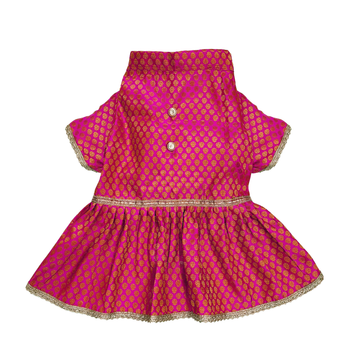Akita Inu

Akita Inu
| Breed Highlight: |
|
The Akita is a large and powerful dog breed with a noble and intimidating presence. They were originally used for guarding royalty and nobility in feudal Japan. These dogs also tracked and hunted wild boar, black bear, and sometimes deer. The Akita does not back down from challenges and does not frighten easily. Consequently, they are fearless and loyal guardians of their families. Yet they are also affectionate, respectful, and amusing dogs when properly trained and socialized. |
| Weight: |
|
25 – 42 kg |
| Height: |
|
58 – 69 cm |
| Life Expectancy: |
| 10-12 years |
| Litter Size: |
| 7-8 Puppies. |
| Breed Appearance: |
|
Akita is muscular, double-coated dogs of ancient Japanese lineage famous for her dignity, courage, and loyalty. In her native land, she's venerated as family protectors and symbols of good health, happiness, and long life. Akitas are burly, heavy-boned spitz-type dogs of imposing stature. Standing 24 to 28 inches at the shoulder, Akitas have a dense coat that comes in several colors, including white. The head is broad and massive, and is balanced in the rear by a full, curled-over tail. The erect ears and dark, shining eyes contribute to an expression of alertness, a hallmark of the breed. Akitas are quiet, fastidious dogs. Wary of strangers and often intolerant of other animals, Akitas will gladly share their silly, affectionate side with family and friends. They thrive on human companionship. The large, independent-thinking Akita is hardwired for protecting those they love. They must be well socialized from birth with people and other dogs. |
| History: |
|
Akitas are Japan’s entry in the ancient canine clan of spitz-type dogs bred around the world on the globe’s northern latitudes. The breed as we know it was developed in the early 17th century in the Akita prefecture of northern Japan. It is said that the emperor banished a wayward nobleman to the prefecture, the northernmost province of the island of Honshu, where the nobleman was ordered to live out his days as a provincial ruler. As it happens, this exiled aristocrat was an ardent dog man and encouraged the barons under his sway to compete in the breeding of a large, versatile hunting dog. Generations of selective breeding produced the Akita, a powerful hunter with a strong work ethic and stout heart who worked in packs on such big game as wild boar, deer, and the fearsome Yezo bear. Owning Akitas was once restricted to the imperial family and their court. In more recent times, just plain folks the world over have employed their Akitas as world-class family guardians. Akitas have for centuries been the object of myth and legend and occupy a special place in Japanese culture. When a child is born, the parents will usually receive an Akita figurine signifying happiness and long life, in keeping with an old Japanese tradition. A famously loyal Akita of the 1920s named Hachiko is among Japan’s most cherished symbols. Various times during the Akita’s long history, the breed teetered on the brink of extinction. To ensure the Akita’s survival, a Japanese national breed club was founded in 1927. Helen Keller is credited with bringing the first Akita to the United States, a gift she received while visiting Japan. Akitas caught on in America after WWII, when returning GIs brought them back from the Pacific. |
| Originally: |
|
The Akita is named for the province of Akita in northern Japan, where they are believed to have originated. The Akita's known existence goes back to the 1600s when the breed guarded Japanese royalty and was used for hunting fowl and large game. |
| Currently Used As: |
|
Akita can be an excellent family dog, especially if trained early and consistently. The Akita can get along well with familiar children, preferring to be around his humans as much as possible. However, he tends to be aloof toward strangers. Because Akita’s bond so closely with their families, they might be happiest as the house's only fur child (they can get jealous if you give too much love to another dog!). But, if introduced in puppyhood, Akitas can live alongside household cats and dogs well. |
| Training: |
|
Akitas are very intelligent and loyal but also have an independent, headstrong nature. As large and very powerful dogs, it is vital that they are trained consistently, beginning in puppyhood. They are instinctive guardians, so it's especially important that Akitas have early and extensive socialization when young. They must learn to accept a wide variety of strangers and not perceive them as a threat. Because of their independence and strong prey drive, they should never be off lead in an unsecured area. Akitas tend to be aggressive toward other dogs, particularly of the same sex, and extreme caution should be used in canine interactions. |
| Health & Care: |
|
Like many dogs, Akitas can experience bloat, a sudden, life-threatening condition where the stomach can twist without veterinary intervention. Bloat is a medical emergency, and Akita owners should learn to recognize the signs. Prospective owners should be sure to work with a reputable breeder who tests his or her breeding stock for health concerns such as eye and thyroid disorders, and hip dysplasia, a malformation of the hip joints that can cause pain and arthritis. |
| Living Condition: |
|
With their thick coats and hardy history, Akitas love spending time outside, and a fenced yard where they can roam and sniff is ideal. If they're outside in the yard, what you'll see is they'll sniff around and then find a spot and lay down. They're not tongue-out, waiting for you to throw the ball. Akitas live for cold weather, and when it comes, they'll zoom around in the snow (they even have slightly webbed toes that help them walk on snowy drifts), eating it and rolling around to their hearts' content. Akitas can become chonky if they don't get enough exercise. And while you don't have to keep their paws moving all day long, a daily jog or long walk will make them happy and fit. Indoors, they're happy to follow their owner from room to room or watch them from the floor. The Akita has a strong prey drive, so he should always be on a leash and under watchful eyes when outside. This breed is relatively quiet, and barking usually isn't an issue unless the dog is alerting its family to a visitor or something unfamiliar. |
| Exercise: |
|
The Akita is generally not a highly active breed but does require moderate exercise. A jog or a brisk walk around the block at least once a day can meet the needs of most individuals of the breed. Akitas also enjoy playing energetically. Although they are large dogs males often weigh more than 100 pounds with sufficient daily exercise Akitas can do well in a relatively small home. They are hardy dogs bred to withstand the harsh outdoor conditions of northern Japan, but they were bred as house dogs and guardians as well as hunters, and adapt very well to life in the home. |
| Grooming: |
|
Akitas tend to be clean and have little 'doggy odour.' They don't require extensive grooming, but their thick, luxurious double coat should be brushed at least once a week to look its best. Although Akitas shed only minimally most of the time, expect their dense undercoat to 'blow' twice a year, where it will shed so profusely that it comes out in clumps all over your house. During this time, it helps to brush the dog more frequently to get rid of the dead coat. The nails should also be trimmed regularly, as overly long nails can cause pain and problems for the dog. Remember also to brush the dog's teeth often to ensure dental health. |
| Pros: |
| Intelligent, Intimidating appearance, Courageous, Loyal, Extremely clean |
| Cons: |
| -Possible aggression around strangers Heavy shedder, Doesn’t’ socialize well with other pets, Stubborn, Strong-willed |












